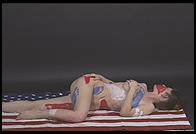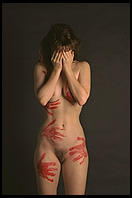
Body Painting
by Philip Greenspun; created 1997
Site Home : Photography : Body Painting

|
Republican Platform. Rather badly scanned from a Fuji Reala negative. This was a test for a poster that would have sold big if Bill Clinton hadn't won the election. |

|
Date Rape. This would have have been a great TIME cover if the public's appetite for date rape stories hadn't faded. |
gathered by Goldlover@aol.com
Q. Can anyone suggest a makeup to use to give the skin a metallic gold or silver look? Any lighting tips would be appreciated as well.
Well, I haven't specifically covered a lot of the skin with metalic paint, but I've been experimenting with body paint a bit. It doesn't seem to be something many people do, as I received little help or suggestions.
The first thing I discovered was: Use grease paint, not water based, if you want a smooth surface, the water based makup dries quickly, which is nice, but cracks up, and doesn't appear even. The grease paint, oth goes on smoothly, needs much smaller quantities, etc...
The grease paint (at least where I live) is readily available in large jars of white, and in pencils, crayons, and small pats in almost every colour you could want. There's a number of blues, a brilliant yellow, several shades of red, and of browns. There is alos a silver, gold, and bronze. The Bronze looks quite metalic, although I've just used it on lips. I think you need to put a fairly substantial layer on with some good contrast (black?) to have it stand out.
The ony thing you want to watch for, though, is that metalics and yellow and red (I think thats it) are often toxic. At least, you shouldn't get them near someones eyes or inside there nose.
As chance would have it I just got back My first Photo CD with body painting. I have three main projects, two of of them very succesful. In the latest we painted up a guy like stone for a gargoyle effect. In the other one we did "robot" imagery on a woman. I have to figure out how to do GIF uploads and file transfers so I can send some of these along. I've also discovered a new paint that works much better than makeup, is cheap and completely safe. It is airbrush fabric paint. It dries to the touch, is not messy, and scrubs off with soap and water. It goes on very fast with either brush or airbrush. It can be worn for hours very comfortably.
Read your post some time ago concerning metallic gold body painting and photography. How did it turn out? Any recommendations for others?
They turned out very well, thanks. I don't know which post you might have read, but the safety information I got was basically "if it's a makeup, then it should be passed by the FDA and have a contents list." Since what I used was, in fact, makeup, it was considered safe.
I used Zauder's brand bodypaint. It is a water based liquid, not an oil based cream. It cleans up much, much easier than the creams. It didn't have quite as smooth a quality as I was looking for, but it was interesting nonetheless.
I got it from Pearl Paint, an art supply store based in New York.
If you have a material you are considering using as a paint, and aren't sure as to the safety, I suggest calling the Arts Crafts and Theater Safety (ACTS) people at (212) 777-0062. They are dedicated to the use of safe materials in the arts, and they are lead by Monona Rosso, who is possibly the world's leading authority on such matters. (She often answers the phone herself, so you might get advice direct from the source.)
As for other technical considerations when photographing a painted subject: I used strobes (tungsten lights just get too hot for modeling work). I would avoid the use of colored gels on the lights. I tried using a red gel for a paritcular effect, and it washed out the gold of the paint. Also consider the fact that the paint will rub off onto just about everything, so put down drop cloths if neccesary, and keep an eye on what your model touches. the last thing I can think of is to make sure your model shaves a few days beforehand.
The paint doesn't work too well in hair, and freshly (even one day old) shaved skin is still sensitive, and caused my model to itch furiously (not fun).
[this answer is from Kevin Graeme, ( kgraeme@facstaff.wisc.edu)]